Trophic Structure of Macrozoobenthos in Permanent Streams in the Eastern Balkans
Abstract
1. Introduction
2. Materials and Methods
2.1. Study Site
2.2. Benthic Macroinvertebrates Data Set
2.3. Data Analysis
2.4. Statistical Analysis
3. Results
3.1. Trophic Structure of the Macroinvertebrates Communities, Dynamics of Abundance and Changes of the FFGs
3.2. Similarity in the Trophic Structure of the Benthic Communities
3.3. Ecological Quality and Classification of the Studied Sites by Different FFG-Based Indices
4. Discussion
5. Conclusions
Author Contributions
Funding
Institutional Review Board Statement
Data Availability Statement
Acknowledgments
Conflicts of Interest
Appendix A
| Autumn 2017 | Spring 2018 | |||||||||
|---|---|---|---|---|---|---|---|---|---|---|
| Site Code | ITC | EQ-Class | RETI | EQ-Class | % SHA | ITC | EQ-Class | RETI | EQ-Class | % SHA |
| 1_BG | 26.73 | II | 0.91 | I | 40 | 30.6 | II | 0.69 | II | 60 |
| 2_BG | 14.25 | III | 0.96 | I | 90 | / | / | / | ||
| 3_BG | 26.44 | II | 0.8 | I | 60 | 26.44 | II | 0.8 | II | 90 |
| 4_BG | 21 | II | 0.41 | III | 10 | 23.64 | II | 0.46 | III | 10 |
| 5_BG | 26.73 | II | 0.77 | III | 70 | 22.88 | II | 0.8 | I | 80 |
| 6_BG | 26.44 | II | 0.57 | III | 30 | 23.64 | II | 0.53 | II | 30 |
| 7_BG | 22.58 | II | 0.75 | II | 80 | 26.44 | II | 0.83 | I | 85 |
| 8_BG | 26.75 | II | 0.84 | I | 70 | 26.75 | II | 0.83 | I | 85 |
| 9_BG | 15.92 | III | 0.94 | I | 10 | 18.73 | III | 0.55 | II | 10 |
| 10_BG | 19.79 | III | 0.9 | I | 80 | 17.15 | III | 0.75 | II | 85 |
| 11_BG | 19.79 | III | 0.81 | I | 95 | 19.79 | III | 0.79 | II | 95 |
| 12_BG | 26.75 | II | 0.66 | II | 20 | 13.85 | III | 0.7 | II | 20 |
| 13_BG | 15.59 | III | 0.96 | I | 90 | 15.59 | III | 0.83 | I | 90 |
| 14_BG | 20.8 | III | 0.64 | II | 70 | 23.94 | II | 0.81 | I | 70 |
| 15_BG | 26.75 | II | 0.66 | II | 60 | 26.75 | II | 0.71 | II | 40 |
| 16_BG | 27.75 | II | 0.8 | I | 90 | 19.79 | III | 0.53 | II | 95 |
| 17_BG | 19.77 | III | 0.99 | I | 90 | 15.92 | III | 0.9 | I | 85 |
| 18_BG | 16.34 | III | 0.5 | III | 80 | / | / | / | ||
| 19_BG | / | / | / | 19.79 | III | 0.81 | I | 90 | ||
| 20_BG | / | / | / | 22.58 | II | 0.47 | III | 50 | ||
| 21_BG | / | / | / | 19.77 | III | 0.67 | II | 90 | ||
| 22_BG | / | / | / | 19.79 | III | 0.9 | I | 50 | ||
| 1_MKD | 16.64 | III | 0.76 | II | 90 | 22.58 | II | 0.68 | II | 95 |
| 2_MKD | 15.92 | III | 0.5 | III | 70 | 22.59 | II | 0.67 | II | 85 |
| 3_MKD | 15.92 | III | 0.82 | I | 75 | 15.59 | III | 0.49 | III | 85 |
| 4_MKD | 18.73 | III | 0.55 | II | 70 | 19.79 | III | 0.59 | II | 75 |
| 5_MKD | 12.95 | IV | 0.21 | V | 70 | 22.59 | II | 0.6 | II | 85 |
| 6_MKD | 18.73 | III | 0.5 | III | 90 | 19.79 | III | 0.65 | II | 95 |
| 7_MKD | / | / | / | 19.44 | III | 0.81 | I | 95 | ||
| 8_MKD | 11.96 | IV | 0.25 | V | 30 | 19.79 | III | 0.35 | III | 10 |
| 9_MKD | 19.79 | III | 0.79 | I | 85 | 19.79 | III | 0.93 | I | 80 |
| 10_MKD | 15.59 | III | 0.85 | I | 85 | 26.44 | II | 0.75 | II | 75 |
| 11_MKD | 8.27 | IV | 0.67 | II | 70 | 18.73 | III | 0.76 | II | 70 |
| 12_MKD | 12.42 | IV | 0.99 | I | 85 | 22.88 | II | 0.81 | I | 95 |
| 13_MKD | 8.27 | IV | 0.92 | I | 80 | 15.59 | III | 0.84 | I | 85 |
| 14_MKD | 10.4 | IV | 0.82 | I | 10 | 20.08 | III | 0.29 | IV | 15 |
| 15_MKD | 19.79 | III | 0.92 | I | 50 | 15.92 | III | 0.94 | I | 55 |
| 16_MKD | 12.79 | IV | 0.7 | II | 10 | 17.4 | III | 0.71 | II | 10 |
References
- Cummins, K.W.; Merritt, R.W.; Andrade, P.C. The use of invertebrate functional groups to characterize ecosystem attributes in selected streams and rivers in south Brazil. Stud. Neotrop. Fauna Environ. 2005, 40, 69–89. [Google Scholar] [CrossRef]
- Tamaris-Turizo, C.E.; Pinilla, A.G.A.; Muñoz, I. Trophic network of aquatic macroinvertebrates along an altitudinal gradient in a Neotropical mountain river. Rev. Bras. Entomol. 2018, 62, 180–187. [Google Scholar] [CrossRef]
- Cummins, K.W. Structure and function of stream ecosystems. Bio Science 1974, 24, 631–641. [Google Scholar] [CrossRef]
- Cummins, K.W.; Klug, M.J. Feeding ecology of stream invertebrates. Annu. Rev. Ecol. Syst. 1979, 10, 147–172. [Google Scholar] [CrossRef]
- Tamaris-Turizo, C.E.; Pinilla, A.G.A.; Guzmán-Soto, C.J.; Granados-Martínez, C.E. Assigning functional feeding groups to aquatic arthropods in a Neotropical mountain river. Aquat. Biol. 2020, 29, 45–57. [Google Scholar] [CrossRef]
- Suriyawong, P.H.; Thapanya, D.; Bergey, E.; Chantaramongkol, P. Aquatic Insect Functional Feeding Groups in a MountainStream with a Series of Check Dams in Northern Thailand. Sains Malays. 2018, 47, 1379–1386. [Google Scholar] [CrossRef]
- Svitok, M.; Novikmec, M.; Bitušík, P.; Máša, B.; Oboňa, J.; Očadlík, M.; Michalková, E. Benthic communities oflow-order streams affected by acid mine drainages: A case study from Central Europe. Water 2014, 6, 1312–1338. [Google Scholar] [CrossRef]
- Ramírez, A.; Gutiérrez-Fonseca, P.E. Functional feeding groups of aquatic insect families in Latin America: A critical analysis and review of existing literature. Rev. Biol. Trop. 2014, 62, 155–167. [Google Scholar] [CrossRef]
- Harvey, E.; Altermatt, F. Regulation of the functional structure of aquatic communities across spatial scales in a major rivernetwork. Ecology 2019, 100, e02633. [Google Scholar] [CrossRef]
- Vannote, R.L.; Minshall, G.W.; Cummins, K.W.; Sedell, J.R.; Cushing, C.E. The river continuum concept. Can. J. Fish. Aquat. Sci. 1980, 37, 130–137. [Google Scholar] [CrossRef]
- Mc Cormick, P.V.; Shuford, R.B.E.; Pawlik, P.S. Changes in macroinvertebrate community structure and function along a river length. Hydrobiologia 2004, 529, 113–132. [Google Scholar] [CrossRef]
- Carlisle, D.M.; Clements, W.H. Leaf litter breakdown, microbioal respiration and shredders production in metal-polluted streams. Freshw. Biol. 2005, 50, 380–391. [Google Scholar] [CrossRef]
- Gregory, K.J. The human role in changing river channels. Geomorphology 2006, 79, 172–191. [Google Scholar] [CrossRef]
- de Vaate, A.B.; Pavluk, T.I. Practicability of the Index of Trophic Completeness for running waters. Hydrobiologia 2004, 519, 49–60. [Google Scholar] [CrossRef]
- Rawer-Jost, C.; Bohmer, J.; Blank, J.; Rahmann, H. Macroinvertebrate functional feeding group methods in ecological assessment. Hydrobiologia 2000, 422, 225–232. [Google Scholar] [CrossRef]
- Pavluk, T.I.; de Vaate, A.B.; Leslie, H.A. Development of an index of trophic completeness for benthic macroinvertebrate communities in flowing waters. Hydrobiologia 2000, 427, 135–141. [Google Scholar] [CrossRef]
- Stepanov, L.N.; Pavluk, T.E. Benthic Fauna Shifts Downstream from Alluvial Gold Mine: A Case Study in a Subpolar Urals River. J. Fish. Aquat. Sci. 2019, 14, 15–24. [Google Scholar] [CrossRef]
- Compin, A.; Céréghino, R. Spatial patterns of macroinvertebrate functional feeding groups in streams in relation to physical variables and land-cover in southwestern France. Landsc. Ecol. 2007, 22, 1215–1225. [Google Scholar] [CrossRef]
- Jourdan, J.; O’Hara, R.B.; Bottarin, R.; Huttunen, K.L.; Kuemmerlen, M.; Monteith, D.; Muotka, T.; Ozoliņš, D.; Paavola, R.; Pilotto, F.; et al. Effects of changing climate on European stream invertebrate communities: A long-term data analysis. Sci. Total Environ. 2018, 621, 588–599. [Google Scholar] [CrossRef]
- Pastorino, P.; Bertoli, M.; Squadrone, S.; Brizio, P.; Piazza, G.; Noser, A.G.O.; Prearo, M.; Abete, M.C.; Pizzul, E. Detection of trace elements in freshwater macrobenthic invertebrates of different functional feeding guilds: A case study in Northeast Italy. Ecohydrol. Hydrobiol. 2019, 19, 428–440. [Google Scholar] [CrossRef]
- TiernodeFigueroa, J.M.; López-Rodríguez, M.J.; Villar-Argaiz, M. Spatial and seasonal variability in the trophic role of aquatic insects: An assessment of functional feeding group applicability. Freshw. Biol. 2019, 64, 954–966. [Google Scholar] [CrossRef]
- González, M.; Graça, M.A. Influence of detritus on the structure of the invertebrate community in a small Portuguese stream. Int. Rev. Hydrobiol. J. Cover. All Asp. Limnol. Mar. Biol. 2005, 90, 534–545. [Google Scholar] [CrossRef]
- Nicola, G.G.; Almodóvar, A.; Elvira, B. Effects of environmental factors and predation on benthic communities in headwater streams. Aquat. Sci. 2010, 72, 419–429. [Google Scholar] [CrossRef]
- Von Fumetti, S.; Nagel, P. A first approach to a faunistic crenon typology based on functional feeding groups. J. Limnol. 2011, 70, 147. [Google Scholar] [CrossRef][Green Version]
- Strzelec, M.; Białek, K.; Spyra, A. Activity of beavers as an ecological factor that affects the benthos of small rivers-a case study in the Żylica River (Poland). Biologia 2018, 73, 577–588. [Google Scholar] [CrossRef]
- Varadinova, E.; Kerakova, M.; Uzunov, Y. Mesta River: Trophic structure of the macrozoobenthos. In Mesta River: Biological Quality Elements and Ecological Status; Uzunov, Y., Pehlivanov, L., Georgiev, B.B., Varadinova, E., Eds.; Professor Marin Drinov Academic Publishing House: Sofia, Bulgaria, 2013; pp. 97–122. [Google Scholar]
- Schweder, H. Neue Indices für die Bewertung des ökologischen Zustandes von Fließgewässern, abgeleitetaus der Makroinvertebraten-Ernährungstypologie. Limnol. Aktuell 1992, 3, 353–377. [Google Scholar]
- Cheshmedjiev, S.; Varadinova, E. Macrozoobenthos. In Biological Analysis and Ecological Status Assessment of Bulgarian Surface Water Ecosystems; Belkinova, D., Gecheva, G., Cheshmedjiev, S., Dimitrova-Dyulgerova, I., Mladenov, R., Marinov, M., Teneva, I., Stoyanov, P., Ivanov, P., Mihov, S., et al., Eds.; University of Plovdiv Pub. House: Plovdiv, Bulgaria, 2013; pp. 147–163. (In Bulgarian) [Google Scholar]
- Kerakova, M.; Ihtimanska, M.; Varadinova, E. Application of trophic indices in ecological state assessment of riverine waterbodies. Bulg. J. Agric. Sci. 2013, 19, 277–281. [Google Scholar]
- Kerakova, M.; Uzunov, Y.; Varadinova, E. Comparison of Trophic Structure of the Benthic Macroinvertebrates in Three Bulgarian Riverine Water Bodies. Turk. J. Zool. 2017, 41, 267–277. [Google Scholar] [CrossRef]
- Varadinova, E.; Sakelarieva, L.; Park, J.; Ivanov, M.; Tyufekchieva, V. Characterisation of Macroinvertebrate Communities in Maritsa River (South Bulgaria)-Relation to Different Environmental Factors and Ecological Status Assessment. Diversity 2022, 14, 833. [Google Scholar] [CrossRef]
- Illies, J. Limnofaunaeuropaea, 2nd ed.; Gustav Fischer: Stuttgart, Germany, 1978; pp. 1–532. [Google Scholar]
- Rimcheska, B.; Vidinova, Y. Ecological Status Assessment of Mountain and Semi-mountain Streams in the Aegean Watershed: Applicability of Biotic Indices BMWP and ASPT Based on Macroinvertebrates. Acta Zool. Bulg. 2020, 72, 49–60. [Google Scholar]
- Cheshmedjiev, S.; Marinov, M. Typology of water ecosystems in Bulgaria (implementation of Water Framework Directive 2000/60/EC). In Proceedings of the Anniversary Scientific Conference of Ecology, Plovdiv, Bulgaria, 1 November 2008; Velcheva, I.G., Tsekov, A.G., Eds.; Plovdiv University Press: Plovdiv, Bulgaria, 2008; pp. 371–383. (In Bulgarian) [Google Scholar]
- West Aegean River Basin Management Plan 2016–2021. Available online: https://wabd.bg/docs/plans/purb1621 (accessed on 15 May 2020).
- Rimcheska, B.; Vidinova, Y. Diversity and structure of macroinvertebrate communities in permanent small streams and rivers in Eastern Balkans. Hydrobiologia 2022, 1–17. [Google Scholar] [CrossRef]
- Cheshmedjiev, S.; Soufi, R.; Vidinova, Y.; Tyufekchieva, V.; Yaneva, I.; Uzunov, Y.; Varadinova, E. Multihabitat sampling method for benthic macroinvertebrate communities in different river types in Bulgaria. Water Research Manag. 2011, 1, 55–58. [Google Scholar]
- EN ISO 10870:2012; Water Quality—Guidelines for the Selection of Sampling Methods and Devices for Benthic Macroinvertebrates in Fresh Waters. Finnish Standards Association: Helsinki, Finland, 2012; p. 26.
- Clarke, K.R.; Gorley, R.N. Primer v6: User Manual/Tutorial. Plymouth Routine in Multivariate Ecological Researc; Primer-e Ltd.: Plymouth, UK, 2006; p. 182. [Google Scholar]
- Young, R.G.; Matthaei, C.D.; Townsend, C.R. Organic matter breakdown and ecosystem metabolism: Functional indicators for assessing river ecosystem health. J. N. Am. Benthol. Soc. 2008, 27, 605–625. [Google Scholar] [CrossRef]
- Jiang, X.; Xiong, J.; Xie, Z.; Chen, Y. Longitudinal patterns of macroinvertebrate functional feeding groups in a Chinese river system: A test for river continuum concept (RCC). Quat. Int. 2011, 244, 289–295. [Google Scholar] [CrossRef]
- Groff, M.H. Does the River Continuum Concept Work in Small Island Streams? Functional Feeding Group Variation Along a Longitudinal Gradient. UC Berkeley: Student Research Papers. 2006. Available online: https://escholarship.org/uc/item/6db9m25g (accessed on 17 April 2020).
- Burgad, A.A.; Clark, S.T.; Furr, M.E.; Lenard, A.N.; Polett, M.E.; Robinson, C.D.; Sherwood, C.R.; Spooner, G.L.; Stoughton, S.J.; Adams, S.R. Longitudinal patterns in an Arkansas River Valley stream: An Application of the River Continuum Concept. J. Ark. Acad. Sci. 2017, 71, 153–164. [Google Scholar] [CrossRef]
- Merrit, R.W.; Cummins, K.W. Trophic relations of macroinvertebrates. In Methods in Stream Ecology; Hauer, F.R., Lamberti, G.A., Eds.; Academic Press Inc.: San Diego, CA, USA, 1996; pp. 453–474. [Google Scholar]
- Bis, B.; Zdanowicz, A.; Zalevski, M. Effects of catchment properties on hydrochemistry habitat complexity and invertebrate community structure in a lowland river. Hydrobiologia 2000, 422–423, 369–387. [Google Scholar] [CrossRef]
- Velasquez, S.M.; Miserendino, M.L. Habitat type and macroinvertebrate assemblages in low order Patagonian streams. Arch. Hydrobiol. 2004, 158, 461–483. [Google Scholar] [CrossRef]
- Barbour, M.T.; Gerritsen, J.; Snyder, B.D.; Stribling, J.B. Revision to Rapid Bioassessment Protocol for Use in Streams and Rivers. In Periphyton, Benthic Macroinvertebrates and Fish, 2nd ed.; EPA841-B-99-002; U.S. Environmental Protection Agency, Office of Water: Washington, DC, USA, 1999. [Google Scholar]
- de Vaate, A.B. Macroinvertebrate communities in the Grensmaas stretch of the river Meuse: 1981–1990. J. Freshw. Ecol. 1995, 10, 75–82. [Google Scholar] [CrossRef]
- Paunović, M.; Jakovčev-Todorović, D.; Simić, V.; Stojanović, B.; Petrović, A. Trophic relations between macroinvertebrates in the Vlasina river (Serbia). Arch. Biol. Sci. 2006, 58, 105–114. [Google Scholar] [CrossRef]
- Shull, D.H.; Mayer, L.M. Dissolution of particle-reactive radionuclides in deposit-feeder digestive fluids. Limnol. Oceanogr. 2002, 47, 1530–1536. [Google Scholar] [CrossRef]
- Varadinova, E.; Uzunov, Y.; Soufi, R. A new integrated index for assessment of the ecological status of rivers as based on functional feeding groups of the macrozoobenthos. J. Environ. Prot. Ecol. 2007, 8, 754–762. [Google Scholar]
- Quinn, J.; Hickey, C.; Linklater, W. Hydraulic influences on periphyton and benthic macroinvertebrates: Simulating the effects of upstream bed roughness. Freshw. Biol. 1996, 35, 301–309. [Google Scholar] [CrossRef]
- Wright, J.F.; Clarke, R.T.; Gunn, R.J.M.; Winder, J.M.; Kneebone, N.T.; Davy-Bowker, J. Response of the flora and macroinvertebrate fauna of a chalk stream site to changes in management. Freshw. Biol. 2003, 48, 894–911. [Google Scholar] [CrossRef]
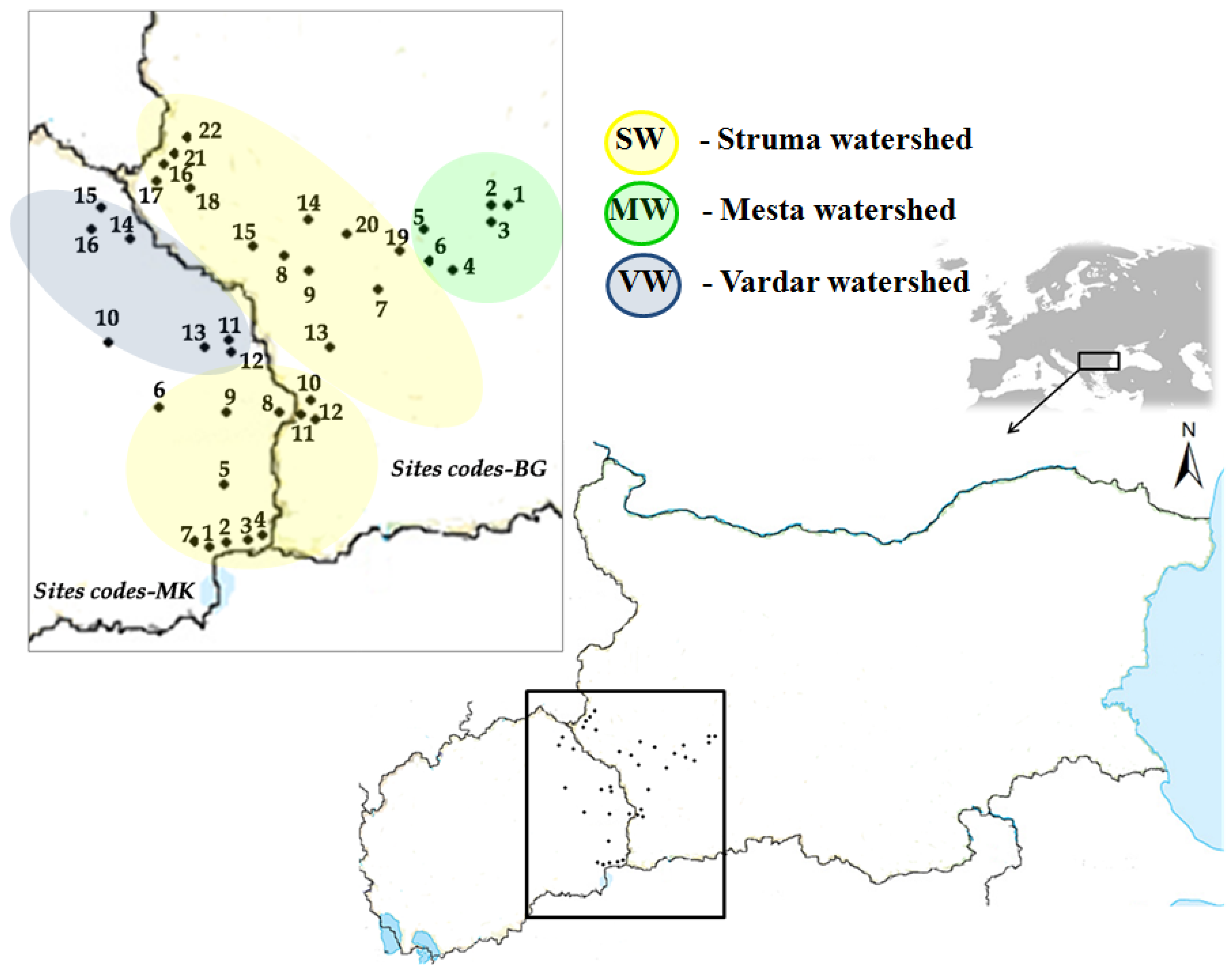
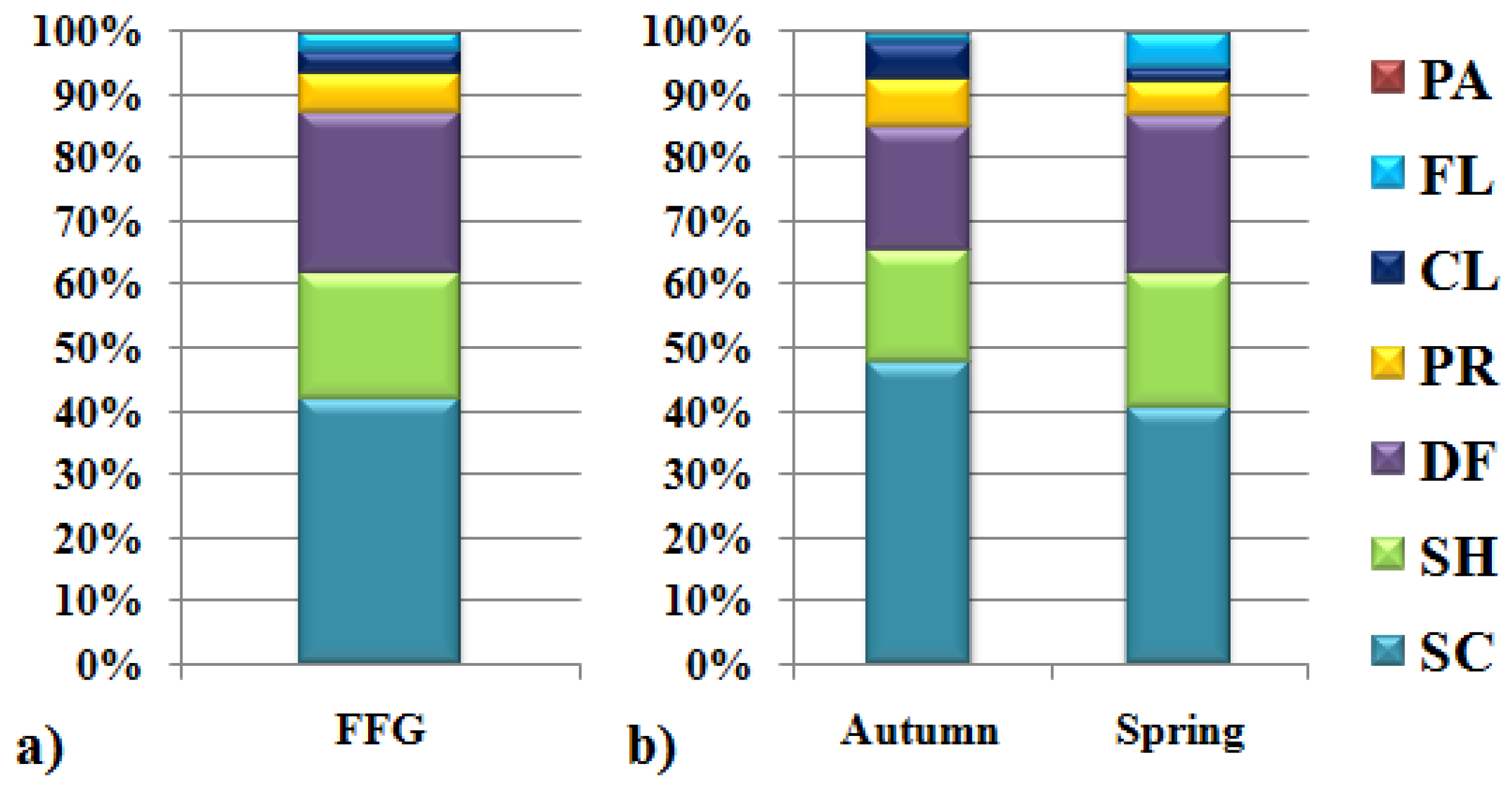
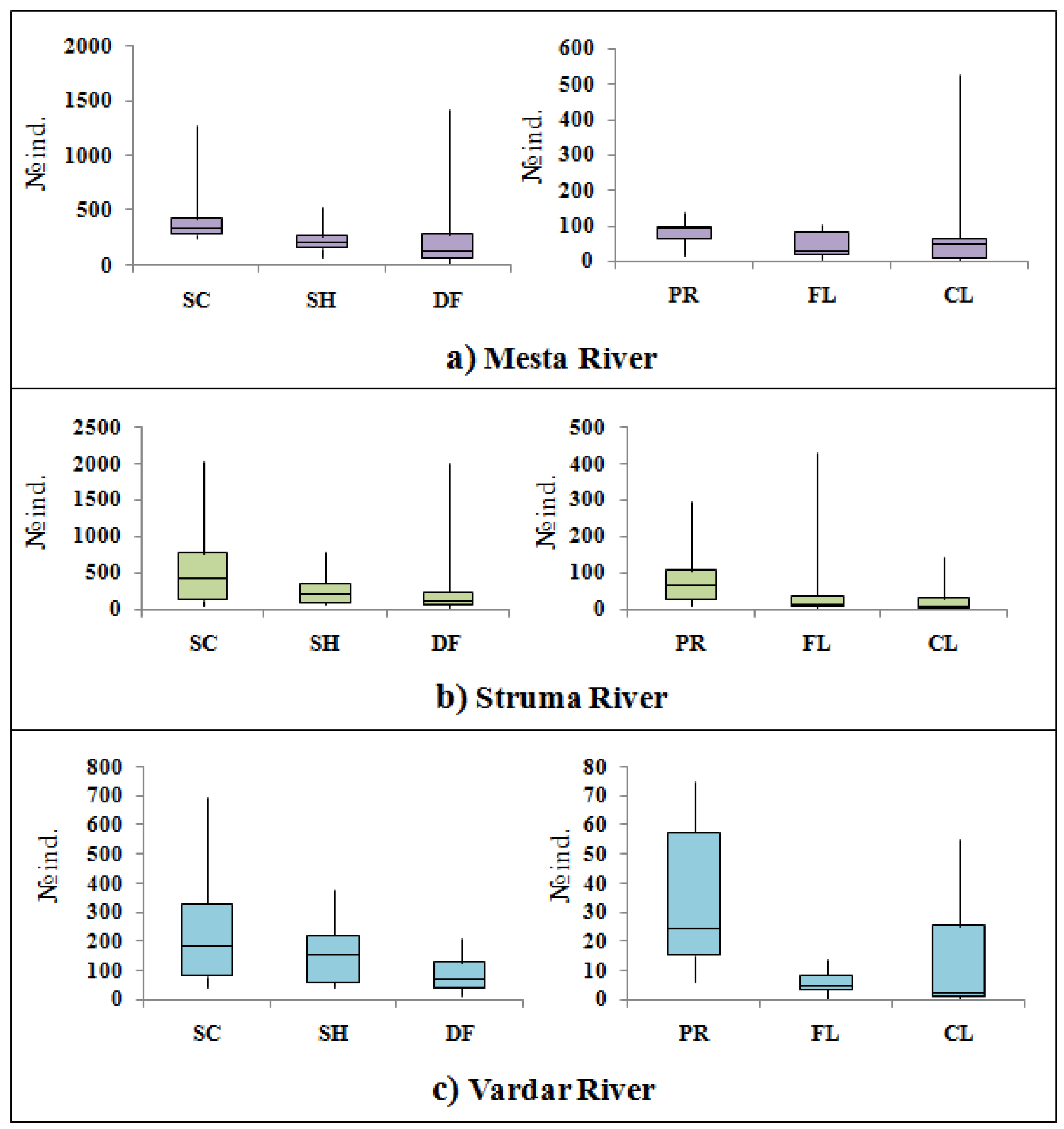

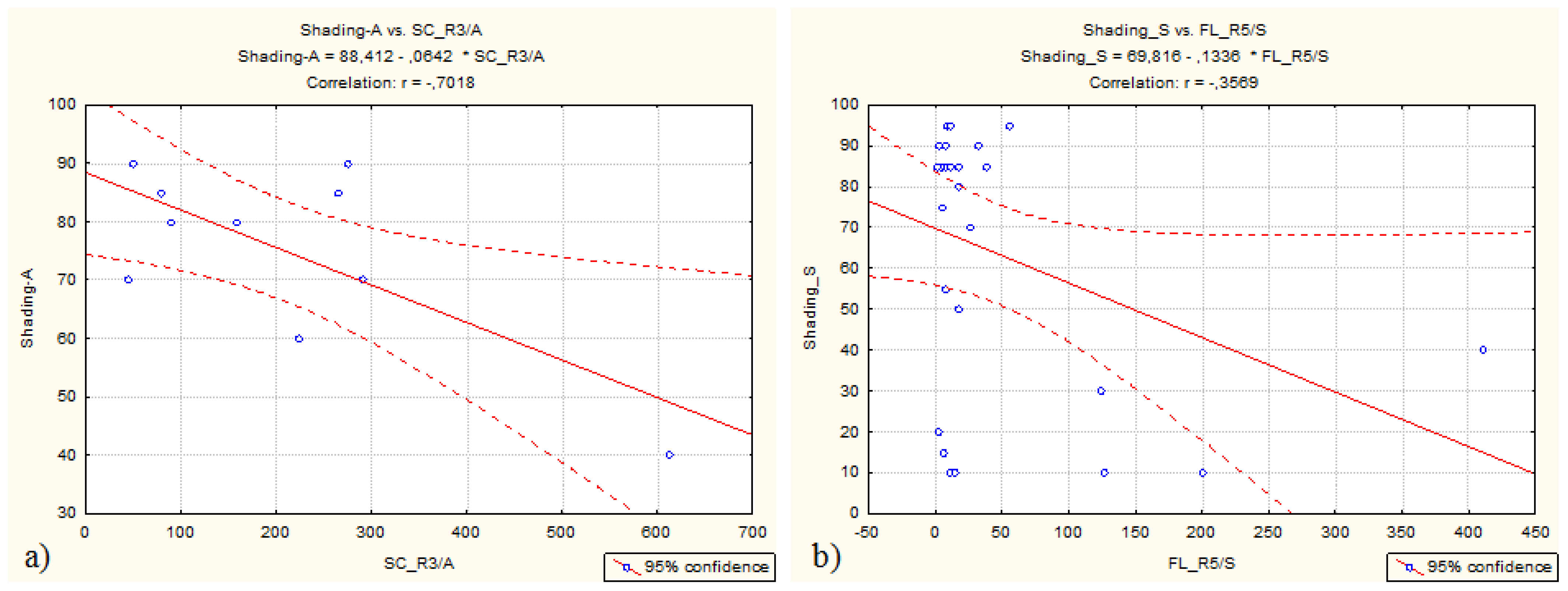
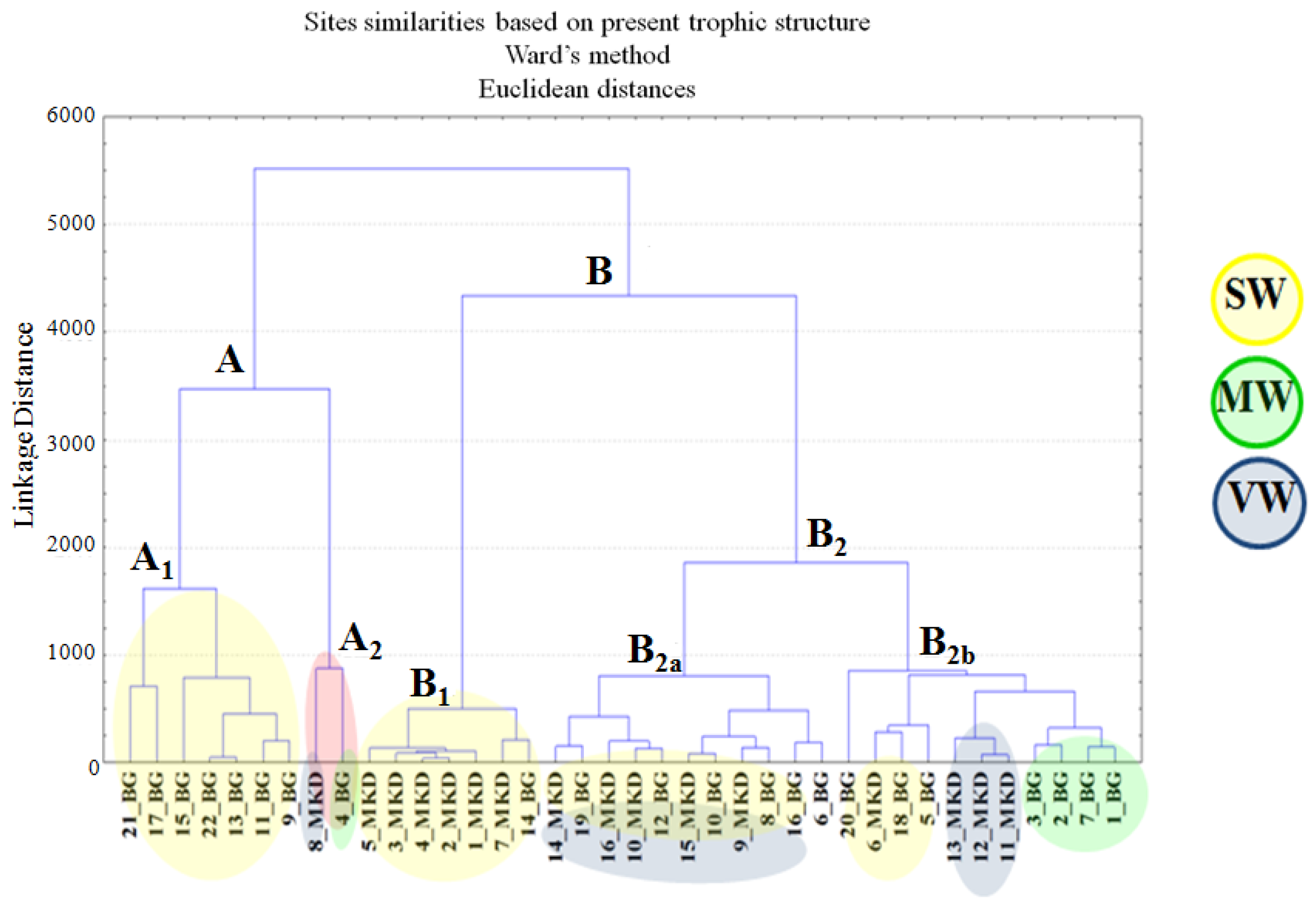
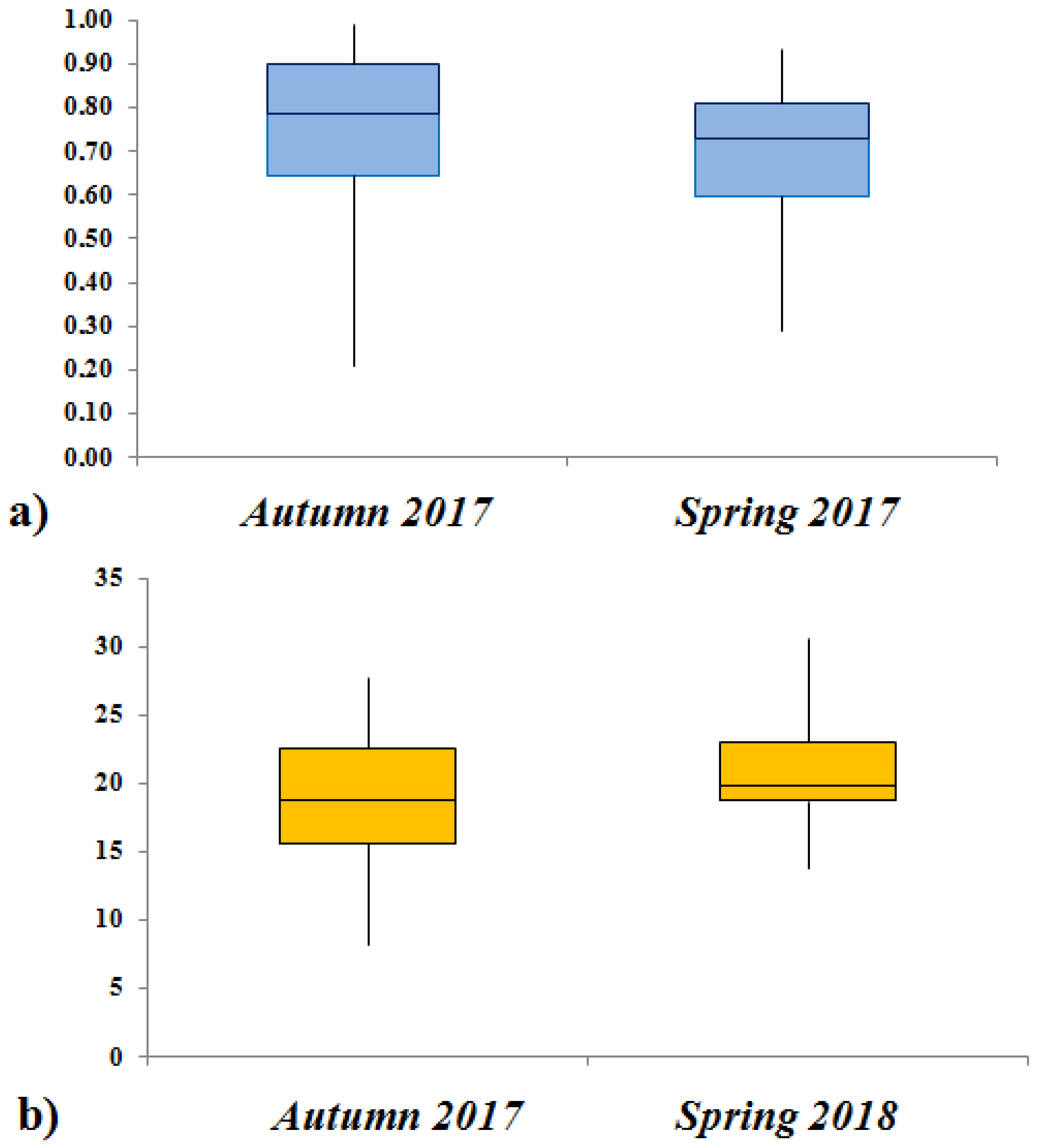

| Systematic Group | Level of Identification |
|---|---|
| Turbellaria | genera, species |
| Oligochaeta | families, genera, species |
| Hirudinea | genera, species |
| Gastropoda | genera, species |
| Bivalvia | genera |
| Crustacea | genera, species |
| Ephemeroptera | genera, species |
| Odonata | genera, species |
| Plecoptera | genera, species |
| Coleoptera | genera, species |
| Heteroptera | genera, species |
| Megaloptera | genera, species |
| Trichoptera | genera, species |
| Diptera | families, genera, species |
| Nematoda | presence |
| River Type/Season | n | SC | SH | PR | DF | FL | CL |
|---|---|---|---|---|---|---|---|
| R3_A | 10 | −0.70 * | −0.38 | −0.12 | 0.02 | −0.15 | −0.35 |
| R3_S | 9 | 0.32 | 0.46 | −0.55 | 0.51 | −0.68 * | 0.10 |
| R5_A | 23 | −0.02 | 0.28 | −0.16 | −0.42 * | −0.24 | −0.40 |
| R5_S | 27 | −0.11 | −0.19 | 0.37 | −0.41 * | −0.36 | −0.26 |
Publisher’s Note: MDPI stays neutral with regard to jurisdictional claims in published maps and institutional affiliations. |
© 2022 by the authors. Licensee MDPI, Basel, Switzerland. This article is an open access article distributed under the terms and conditions of the Creative Commons Attribution (CC BY) license (https://creativecommons.org/licenses/by/4.0/).
Share and Cite
Rimcheska, B.; Vidinova, Y.; Varadinova, E. Trophic Structure of Macrozoobenthos in Permanent Streams in the Eastern Balkans. Diversity 2022, 14, 1121. https://doi.org/10.3390/d14121121
Rimcheska B, Vidinova Y, Varadinova E. Trophic Structure of Macrozoobenthos in Permanent Streams in the Eastern Balkans. Diversity. 2022; 14(12):1121. https://doi.org/10.3390/d14121121
Chicago/Turabian StyleRimcheska, Biljana, Yanka Vidinova, and Emilia Varadinova. 2022. "Trophic Structure of Macrozoobenthos in Permanent Streams in the Eastern Balkans" Diversity 14, no. 12: 1121. https://doi.org/10.3390/d14121121
APA StyleRimcheska, B., Vidinova, Y., & Varadinova, E. (2022). Trophic Structure of Macrozoobenthos in Permanent Streams in the Eastern Balkans. Diversity, 14(12), 1121. https://doi.org/10.3390/d14121121






